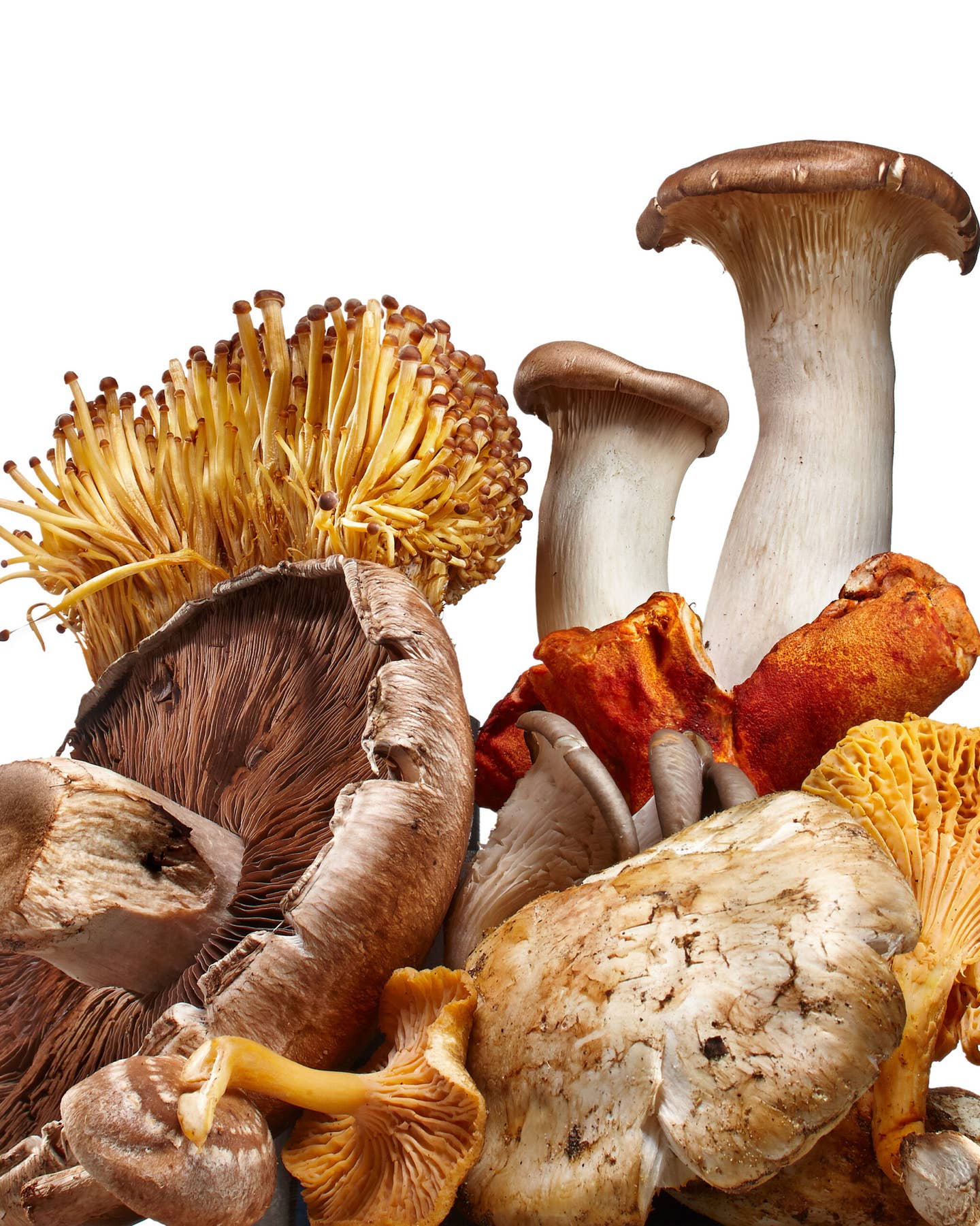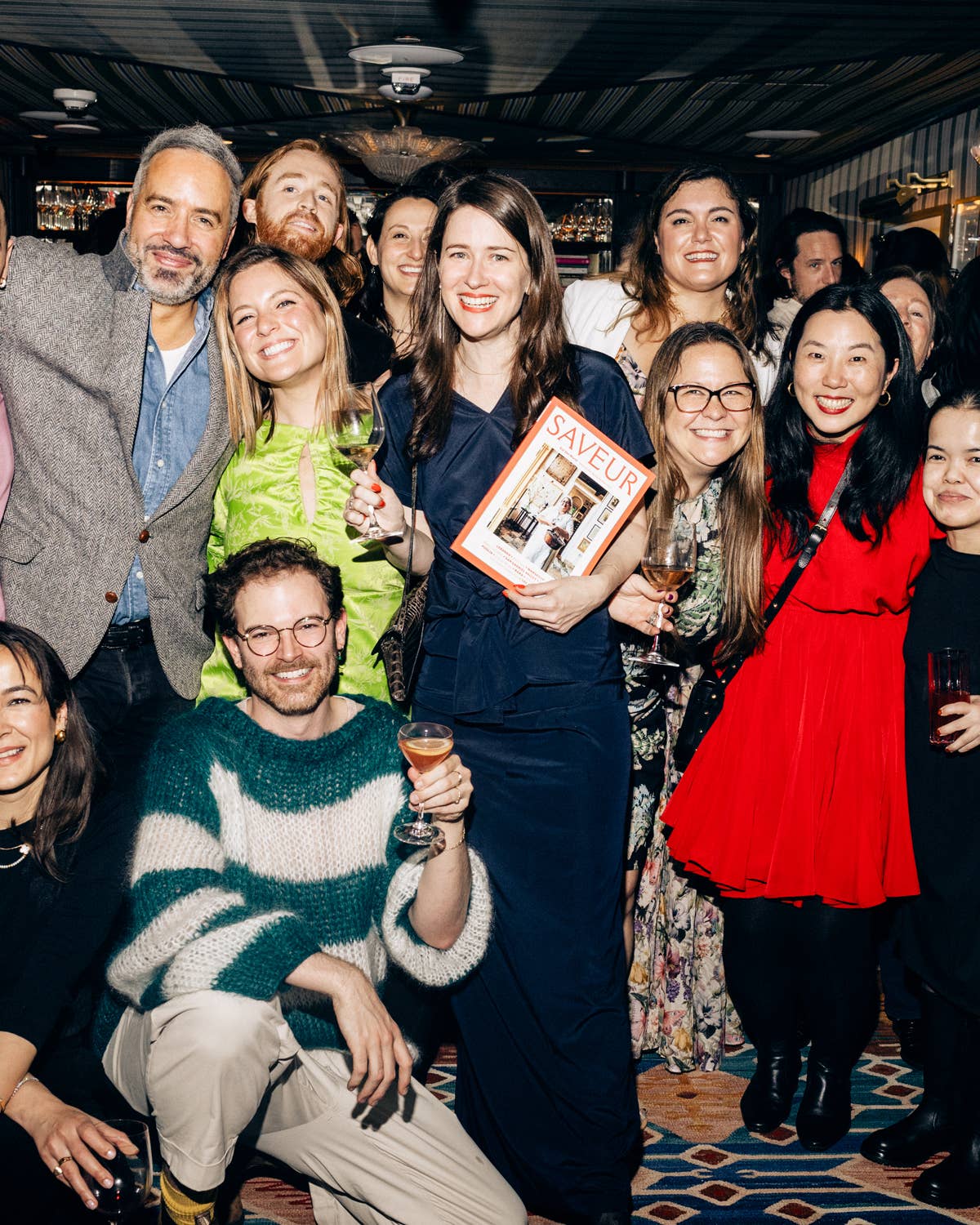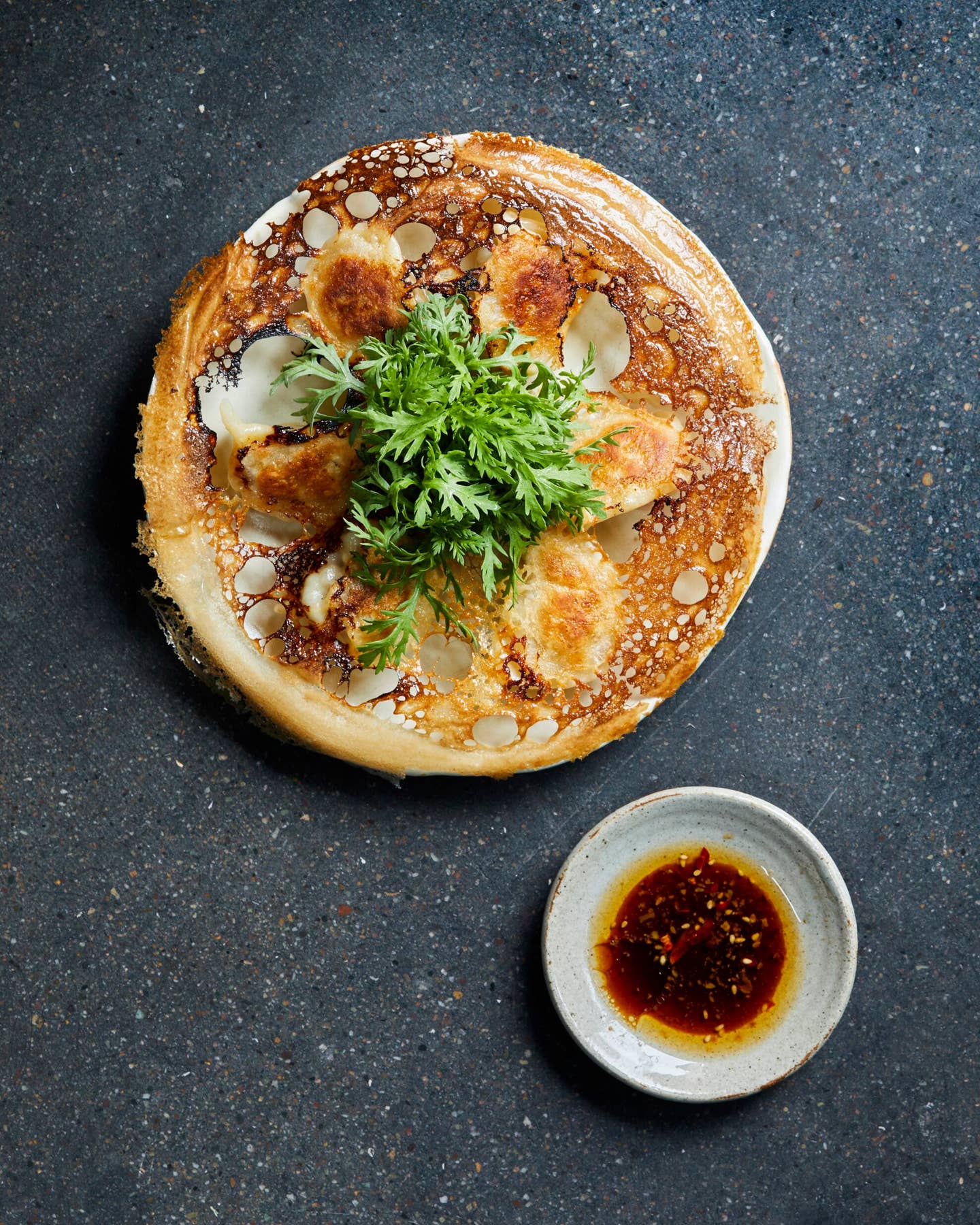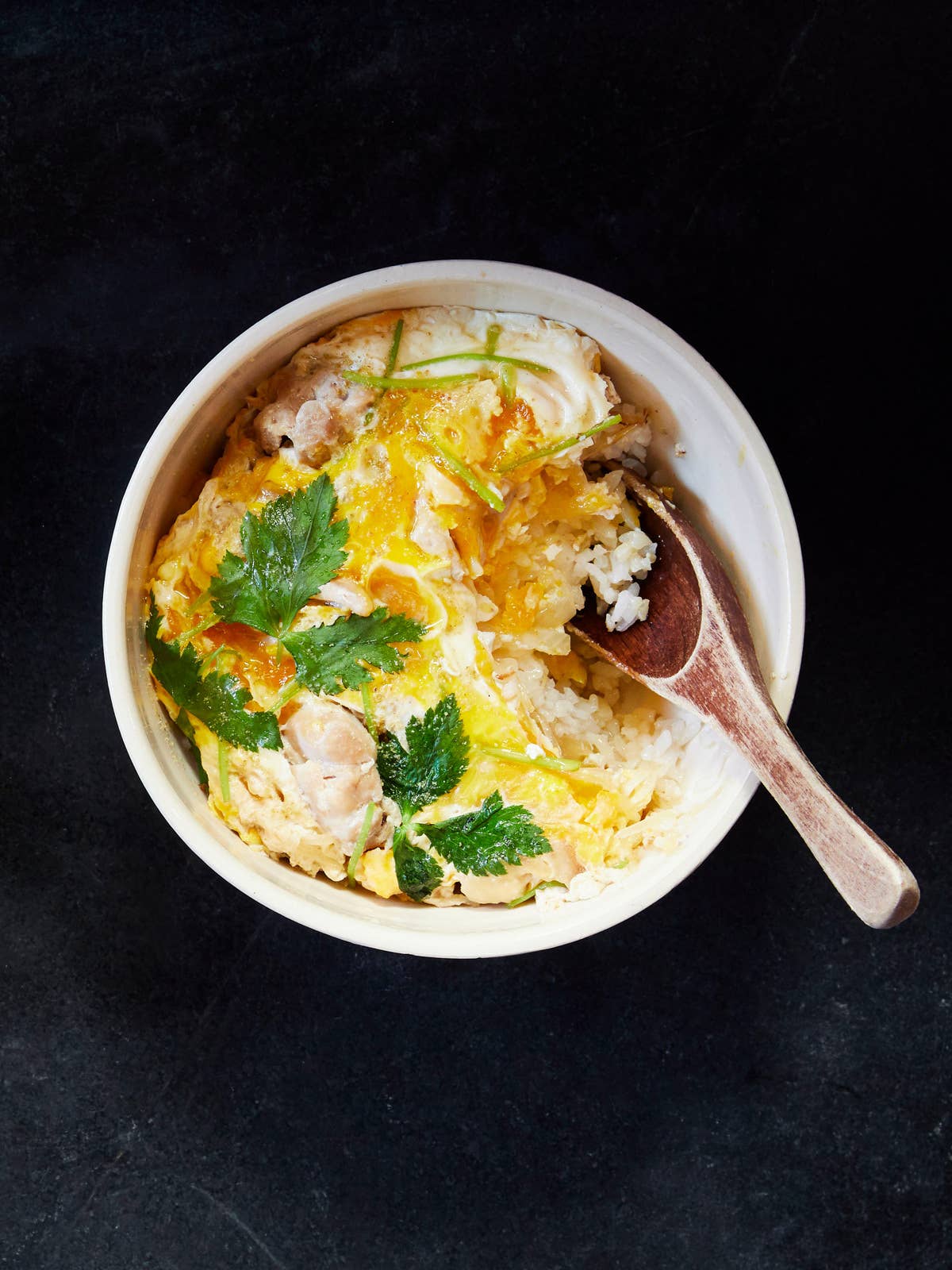I Went to Mushroom Camp and Came Home with These Incredible Fungi Facts
My top 12 takeaways from a weekend spent cooking, foraging, and bunking up with mycophiles in the California redwoods.

It’s been two months since I got back from mushroom camp, and I still can't stop thinking about the wild cast of characters I met there. A former professor offered me a bump of pine pollen and suggested listening to fermenting herbal syrups as a sleep aid. Another guy walked around with two jars of mushrooms—one pickled, one psilocybin (he only offered to share the psychedelics). And, of course, there were dozens of other casual mycophiles like me who simply love a good fungus fair.
SOMA Wild Mushroom Camp is held annually by the Sonoma County Mycological Association in the redwood forests of Northern California. A mix of foraging excursions, botany classes, tastings, and other fungus-centric activities, the gathering raises funds for mushroom scholarship. I had signed up for a work exchange spot, hoping to glean the knowledge and connections to comfortably forage my own mushrooms, something I’d wanted to do for decades.
Now, you might wonder: Why travel all the way to mushroom camp when there are so many field guides and YouTube videos and how-to articles out there? In short, you can’t truly study fungi in isolation. You have to learn about weather patterns, tree species, federal laws and local regulations, and even the ecology of the land you’re on. Take hedgehog mushrooms, for instance. Even if you can identify them, they’re hard to find—unless you know they grow near huckleberry bushes. Books will tell you that morels thrive in woodlands—but most fail to mention that those harvested in wildfire-scorched areas are tastier than normal ones. For that kind of knowledge, I learned, it pays to go to mushroom camp.
After a weekend spent foraging, attending lectures, and cooking by day (and bunking up with mycology geeks by night), I came away with even more mushroom cooking tips than I bargained for. Here are my 12 top takeaways.
Mushrooms aren’t always interchangeable.
There are about 350 edible mushroom species. Of these, some take well to grilling and roasting, while others taste best in soup, meaning your mushroom cooking techniques should change depending on what variety you're working with. Chef and recipe developer Kate Ray told me she likes boiling tiny enoki mushrooms in hotpot and other water-based preparations, while lion’s mane mushrooms make a knockout vegetarian “steak,” since “the bigger and meatier the mushroom, the more it makes sense to sear or roast a big chunk.”
Truffles are mushrooms too!
It turns out “mushroom” is a catch-all term, like “vegetable.” Though it’s often defined as the fruiting body of a fungus with a stem and a gill-lined cap, lots of fungi diverge from this model, such as hedgehog, porcini, and subterranean stem-and-cap-free truffles. Stephanie Jarvis of Pacific Truffle Growers shared more details about truffles: They grow well in hazelnut orchards, but because of their interactions with tree roots, a truffle orchard won’t produce nice nuts—you can have hazelnuts or truffles, but not both! I was surprised to learn that the U.S. has its own native truffle species (I’m envious of Oregonians with their annual truffle dog contest). One thing that isn’t a mushroom? Truffle oil, which is usually truffle-free and made instead with a lab-produced compound called 2,4-dithiapentane.
Learning to avoid poisonous mushrooms isn’t so hard.
According to UC Berkeley postdoctoral researcher Cat Adams, who studies death cap mushrooms, only 28 mushroom species are known to be deadly, while there are hundreds of edible types and tens of thousands of described species. You don't need comprehensive knowledge of every mushroom to safely forage—but it’s important to be able to identify local poisonous varieties. Most mushroom-related deaths in the U.S. are foragers from foreign countries who didn’t do their due diligence. As the old mushroomers’ maxim goes: when in doubt, throw it out.
Don’t stop at savory.
At camp I tried witches’ butter syrup, matsutake fig jam, and the most delightful profiterole I’ve eaten—filled with ganache, whipped cream, and candy cap mushroom ice cream. Candy caps, which have a lovely maple flavor, are an easy entry into mushroom desserts, but Ray (the aforementioned chef) is pushing boundaries with treats like shiitake chip cookies and mushroom pavlova. One caveat: “Mushroom desserts are an acquired taste and tend to hit more with people who already like mushrooms,” she said. Mushroom chocolates, mainly featuring psychedelic or medicinal varieties, are another frontier to explore, though they’re not new: The Aztecs mixed psilocybin mushrooms with cacao.
Mold isn’t a four-letter word.
Funguses in culinary contexts are often limited to yeasts and mushrooms, but molds, too, are intriguing. Tempeh is made by inoculating soybeans with Rhizopus microsporus; while tempeh is popular and delightful, this mold in its undomesticated form can also cause a rare but deadly disease called mucormycosis. Despite the possible dangers of molds, Oregon State University botany and plant pathology student Brandon Stairs, who presented research on Rhizopus species, said, of eating a piece of bread with a bit of mold on it, “It depends on how hungry I am.”
Drink your mushrooms.
Mushroom tea is widespread in Asian traditional medicine and a common way to ingest psychedelic mushrooms, but there’s no need to stop there. At camp I tried cordyceps tea, matsutake sake, and guava and hibiscus-berry kombucha fermented with stinkhorns (I skipped the cannabis reishi limoncello). The kombucha was an invention by Michelle Harris, a designer who was inspired by seeing dried stinkhorns, which she hadn’t realized were edible, for sale in San Francisco Chinatown. One of her pet peeves is “an edible mushroom deemed as non-palatable by one and then in a game of telephone reported as being inedible and toxic in another source,” so she set out to do some research and make something with stinkhorns, yielding a tart and refreshing result.
You don’t need a fancy kit to grow your own mushrooms.
You can order inoculated grain, which has mycelium growing on it, and add it to a plastic bagful of sterile organic material like straw or sawdust to make your own grow bags. Or you can make a mushroom log for your yard, drilling holes and inserting inoculated wooden dowels. Some varieties, like oyster mushrooms, grow easily and wildly fast, while others, like chanterelles and truffles, are more resistant to cultivation and are still mostly foraged.
There’s more to miso than the white, yellow, and red.
Miso is another fungus-based food. To make it, soy beans are fermented with salt and kōji mold. However, at a SOMA workshop led by Eleana Hsu of ferment company Shared Cultures, we made miso from chickpeas, black trumpet mushrooms, salt, and kōji, all mashed together by hand (with considerable effort). Shared Cultures makes a variety of “modern misos” out of everything from morels to Cool Ranch Doritos that have won over the Bay Area food scene.
Stop and smell the mushrooms.
In her book The Mushroom at the End of the World, anthropologist Anna Lowenhaupt Tsing writes that the smell of matsutake “evokes sadness in the loss of summer’s easy riches, but it also calls up the sharp intensity and heightened sensibilities of autumn.” Mushrooms, then, can speak to the season just like a late-summer tomato—if you slow down and notice. Traditional Japanese preparations like matsutake rice and suimono use simple, almost bland ingredients to let the cinnamon-scented mushroom take center stage.
Go ahead, wash your mushrooms.
“Don’t be afraid to get your mushrooms wet!” said chef Rebecca Peizer during a demo at camp, noting that many grow in wet environments. Soaking is a no-no, however, since many mushrooms—especially those with exposed gills like portobellos or teeth like hedgehog mushrooms—readily absorb water, which can turn them soggy. If your mushrooms are already pretty clean, as most cultivated ones are, you probably don’t need to wash them—a little dirt won’t hurt you.
Mushrooms and crabs have a weird thing in common.
Mushroom cell walls are made of chitin—and so are the exoskeletons of insects and crustaceans. There is a misperception that because humans can’t digest chitin, we should always cook mushrooms in order to break it down. Dr. George C. Fahey Jr., emeritus professor of nutritional science at the University of Illinois Urbana-Champaign, has researched the nutritional value of mushrooms and disagrees. “Chitin is a form of fiber,” he said. “If the mushroom is edible and you like it raw, then eat it.” Chitin has other benefits too—it’s the reason it’s pretty much impossible to overcook a mushroom, short of burning it to a crisp.
There’s still a lot to learn.
Herbalist and teacher Autumn Summers started off one introductory session saying, “I’ve been foraging for mushrooms for a long time, but we’re all still beginners.” Fungi remain understudied and misunderstood. There’s research funded by groups trying to sell you stinkhorn aphrodisiacs. There are cultural biases against eating certain mushrooms, some with good reasons for caution. And the knowledge we have is constantly changing: Just last month, scientists published new research identifying a toxin that allows oyster mushrooms, apparently carnivorous, to kill and eat worms.
Keep Reading
Continue to Next Story










